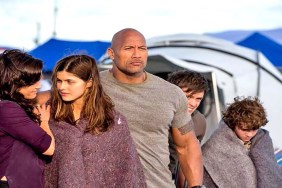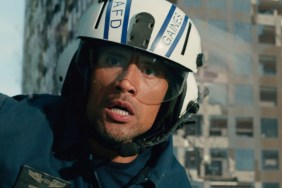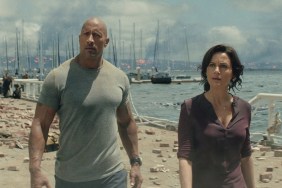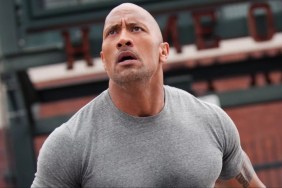
For as long as there have been movies, there have also been disaster films.
Disaster movies go as far back as 1901, when the movie Fire! was made during the era of silent films. Nearly every decade since then has had a signature disaster movie, several of which have become blockbuster hits. Hollywood has made a very lucrative art form out of wide-scale destruction.
Why do we keep coming back to disaster movies? There’s an undeniable thrill to seeing some of our most famous iconography get destroyed onscreen. Roland Emmerich has pretty much made his entire career by continuously tapping into that desire.
What if, on a more basic level, what really attracts us to disaster movies are the everyman heroes and heroines who step up against overwhelming odds to save their family, friends, and even complete strangers? When the worst comes, we want to believe that our shared humanity will see us through safely. Almost every disaster movie follows that formula, and the selfish people rarely get out alive.
On May 29, Dwayne “The Rock” Johnson’s latest film, San Andreas, shakes its way into theaters. San Andreas keeps the disaster movie recipe alive by following a man trying to save his family (as played by Carla Gugino and Alexandra Daddario) against the backdrop of a massive earthquake that levels most of California.
It’s a pretty safe bet that the characters played by Johnson, Gugino, and Daddario will make it out safely while millions perish in the background. That’s not the point. The point is whether we enjoy watching that play out and if San Andreas can take its place alongside some of Hollywood’s biggest disaster movies.
While we await the critical verdict on San Andreas, ComingSoon.net has taken a look back at 15 of the Biggest Disaster Movies of all time. And if you don’t agree with our picks, share your own in the comment section below!
On a desktop, you can click Full Screen to read each entry!
The 15 Biggest Disaster Movies
-
Godzilla (1954)

There are two versions of this movie. The North American edition with Raymond Burr (Perry Mason) as a reporter, and the original version of the film from Japan, which was called Gojira. Personally, I think that Gojira is the superior version.
Sure, Godzilla is a beloved movie monster now, but at the time that Gojira was made, it hadn’t even been a decade since the atomic bombs were dropped on Hiroshima and Nagasaki. The Godzilla of this movie personifies the destructive power of the nuclear weapons that resurrected him in the present.
It doesn’t even matter that Godzilla was portrayed by a man in a rubber suit who laid waste to obviously fake cities. The film’s entertainment value far surpasses its limitations. This was the true birth of the kaiju genre, and all giant monster movies owe a debt to the King of the Monsters himself.
-
Airport (1970)

Airport ushered in the 1970s with a new breed of disaster film. The movie adapted Arthur Hailey's novel of the same name with an all-star cast that included Burt Lancaster, Dean Martin, Jean Seberg, Jacqueline Bisset, George Kennedy, Helen Hayes, and Van Heflin.
The story revolves around the crew and the pilots of the fictional Lincoln International Airport as they deal with the simultaneous crises of a massive snowstorm and a bomb on one of the airplanes.
By modern standards, Airport is considered campy and it’s been largely ridiculed for years. But at the time, Airport was critically acclaimed and it was nominated for Best Picture at the Oscars. Hayes actually won the Academy Award for Best Supporting Actress because of her role as an elderly stowaway in this movie!
If nothing else, Airport eventually gave us the unforgettable parody film, Airplane! Although we can also thank the film Zero Hour! for that one.
-
The Poseidon Adventure (1972)

While The Poseidon Adventure was directed by Ronald Neame, it was also the movie that made producer Irwin Allen into the "Master of Disaster."
The Poseidon Adventure was also a blockbuster hit that paved the way for even bigger disaster movies to come. This time out, the all-star cast was led by Gene Hackman, Ernest Borgnine, Red Buttons, Carol Lynley, Shelley Winters, Roddy McDowall, Stella Stevens, Jack Albertson, Pamela Sue Martin, Arthur O'Connell, Eric Shea, and Leslie Nielsen.
After a massive tidal wave tipped over the SS Poseidon, the desperate survivors had to make their way towards the bottom of the capsized ship to make their escape. Needless to say, not everyone made it.
The Poseidon Adventure has been often imitated and it was even remade twice, not counting the sequel, Beyond The Poseidon Adventure. But nothing matched the power of the original.
-
The Towering Inferno (1974)

Irwin Allen struck gold again two years later with The Towering Inferno. John Guillermin was the director this time, and screenwriter Stirling Silliphant successfully adapted Richard Martin Stern’s The Tower and Thomas N. Scortia’s The Glass Inferno into a single story.
Even by today’s standards, The Towering Inferno had a dream cast that included Steve McQueen, Paul Newman, William Holden, Faye Dunaway, Fred Astaire, Susan Blakely, Richard Chamberlain, Robert Vaughn, Robert Wagner, Susan Flannery, Gregory Sierra, Dabney Coleman, Jennifer Jones...and O.J. Simpson decades before he was accused of murder.
As the name suggests, a fire in the world’s tallest building led to a desperate attempt to escape by the people trapped inside. We may all know the formula by now, but at the time, The Towering Inferno was another smash hit for Allen.
-
Earthquake (1974)

San Andreas is far from the first disaster movie to play on the idea of California suffering a devastating earthquake. The movie Earthquake just happened to beat it by 41 years.
The Godfather author and Superman screenwriter, Mario Puzo co-wrote Earthquake with George Fox for director Mark Robson. The cast was equally impressive, with Charlton Heston, Ava Gardner, George Kennedy, Lorne Greene, Geneviève Bujold, Richard Roundtree, Marjoe Gortner, Barry Sullivan, Lloyd Nolan, Victoria Principal, and Walter Matthau in leading roles.
The biggest legacy of Earthquake was its use of Sensurround to simulate the sounds of an earthquake in the movie theaters. This led to the surround sound innovations that have become commonplace in film.
-
Independence Day (1996)

The disaster film genre was largely dormant in the ‘80s. It wasn’t until Independence Day came along that the disaster movie made a big time comeback.
Although Independence Day is technically a sci-fi, alien invasion film, it is also unquestionably a disaster movie that revels in destroying several American landmarks. The scene of the alien ship blasting the White House into oblivion has become iconic in the nearly two decades since this movie was released.
Director and co-writer Roland Emmerich continued his collaboration with producer and co-writer Dean Devlin with a cast that included Bill Pullman, Jeff Goldblum, Mary McDonnell, Judd Hirsch, Randy Quaid, Robert Loggia, James Rebhorn, Harvey Fierstein, Vivica A. Fox, and Will Smith in the role that arguably made him into a movie star.
An Independence Day sequel has been promised for years, but it now has finally gotten underway, with a projected release date in June 2016.
-
Twister (1996)

Disaster movies got another shot in the arm when Twister was also one of the biggest hits of 1996. Unlike most disaster films, Twister had a relatively small cast that included Bill Paxton and Helen Hunt as a pair of stormchasers who ran towards danger in the middle of tornado season.
Paxton and Hunt were both temporarily blinded during the making of this film, and director Jan De Bont was criticized for not paying enough attention to the safety of his actors and his crew. Cinematographer Jack N. Green was even injured when he was trapped in a house set that was prematurely collapsed.
Regardless of the behind-the-scenes issues, Twister’s box office clout raised De Bont’s profile and helped pave the way for a new era in disaster filmmaking.
-
Titanic (1997)

Wait... isn’t Titanic a poorly-acted melodrama with terrible writing? Or is it an overblown and sappy romance story with an ear-splitting Celine Dion song in the soundtrack?
Yes, it’s all of those things. And I dare you not to laugh when Leonardo DiCaprio says “this is horses***!” Or any time that Billy Zane opens his mouth.
But in addition to being the second-highest grossing movie of all time, Titanic is also a disaster film. Director James Cameron’s depiction of the Titanic’s destruction is still one of the most visually-arresting sequences on film.
And even with Cameron’s tendency to go over-the-top, the film still has moments that capture powerful emotional beats like the band playing together as the ship sinks and the crushing guilt of the would-be rescuers as they realize how many lives have been lost.
No matter how you feel about the film itself, Titanic has earned its place among the top disaster movies.
-
Dante’s Peak (1997)

1997 was also the year of the two dueling volcano films. And while nobody seems to really like Volcano, Dante’s Peak benefited from having Pierce Brosnan and Linda Hamilton in the leading roles.
CGI was still in its infancy during the late ‘90s, but most of the effects in Dante’s Peak hold up well even after nearly twenty years. Dante’s Peak is also a reminder that having a good cast can help the audience overlook the flaws of a film and just enjoy the ride.
-
Armageddon (1998)

In 1998, there were two competing disaster films about asteroids hitting the Earth. But while Deep Impact failed to live up to its name, Michael Bay’s Armageddon led to another new era of disaster movies.
Bruce Willis, Ben Affleck, Liv Tyler, Billy Bob Thornton, Will Patton, Keith David, Michael Clarke Duncan, and Steve Buscemi headlined the extremely unlike story of oil drillers who were recruited by NASA to take a shuttle into space and nuke an asteroid before it wiped out life on Earth.
This film is relentlessly stupid, but it was also the highest grossing movie of the year. Regardless of how you feel about Bay’s skills as a director, his films have been huge successes. Armageddon was only the third feature of Bay’s career, but it set him on the path that he’s currently on.
-
The Perfect Storm (2000)

Director Wolfgang Peterson’s The Perfect Storm seems oddly intimate when compared to other disaster movies. The movie follows the crew of the doomed fishing ship, the Andrea Gail as it unknowingly sails into two powerful storm fronts.
George Clooney and Mark Wahlberg headlined the cast of The Perfect Storm, which also included Diane Lane, John C. Reilly, Mary Elizabeth Mastrantonio, William Fichtner, Bob Gunton, and Karen Allen.
The Perfect Storm was based on Sebastian Junger’s novel about the real Andrea Gail disaster. The movie maintains the decidedly unhappy ending from the novel and the story that inspired it, which earns it a unique place in disaster movie history.
-
The Day After Tomorrow (2004)

Director Roland Emmerich got to destroy America again in The Day After Tomorrow, the (wildly) scientifically inaccurate movie that depicts the rise of a new global ice age after a few cataclysmic storms.
The destruction in the movie takes place largely from the perspective of Professor Jack Hall (Dennis Quaid) as he fruitlessly attempts to warn the world in time before going on a dangerous trip to the frozen New York City to rescue his son, Sam (Jake Gyllenhaal).
Weirdly, the characters in The Day After Tomorrow seem even less relatable than the ones in Emmerich’s Independence Day. But Emmerich wasn’t wrong to focus on the scenes of environmental catastrophe. There’s still a large appetite for that among the moviegoing public and this film made over half a billion dollars worldwide.
-
2012 (2009)

One might call this one “John Cusack: The Movie,” because his character’s heroics in 2012 are so over-the-top that it’s comical.
Roland Emmerich’s latest disaster film played up the Mayan 2012 prophecies that had doomsday cults and conspiracy theorists so worried three years ago.
Cusack plays a struggling sci-fi writer and limo driver named Jackson Curtis, who attempts to lead his family to safety amid a global catastrophe. 2012 is far from Emmerich’s best film, but it made a staggering $791 million at the global box office, which is more than enough to land it among the biggest disaster movies of all time.
-
Contagion (2011)

Steven Soderbergh’s Contagion isn’t quite as destructive as other disaster movies, but it does harken back to the all-star cast days with a lineup that includes Laurence Fishburne, Jude Law, Marion Cotillard, Bryan Cranston, Matt Damon, Gwyneth Paltrow, Kate Winslet, and Jennifer Ehle.
The most striking thing about Contagion is how it taps into modern fears. The disaster in question isn’t a meteor, an alien invasion or a cataclysmic act of God. It’s a fast spreading virus that quickly outpaces attempts to hold it in check.
It’s the superbug that we’re all afraid of, and it’s winning.
-
The Impossible (2012)

The Impossible does something almost impossible: It makes water scary.
Inspired by the 2004 Indian Ocean Tsunami, The Impossible recreates the harrowing events in Thailand as Henry (Ewan McGregor) and Maria Bennett (Naomi Watts) are caught in the middle of it and separated from their children. This is the only film on this list where the natural disaster actually happened, which also lends more gravitas to the story as it plays out on screen.
Director J. A. Bayona did use some CGI for the water effects, but a lot of the shots include real water for a more authentic look. Additionally, McGregor and Watts both gave very good performances that helped strengthen The Impossible’s story.










